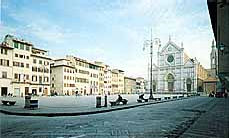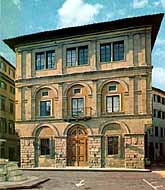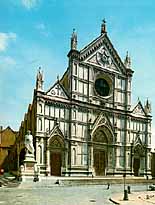
Piazza Santa Croce
The huge rectangular space of Piazza Santa Croce, created in front of the Franciscan Basilica, is the result of a 13th-14th century urban project whose mediaeval origins can still be clearly seen in many of the buildings surrounding its perimeter. However the two most famous palaces in the square actually date from a later period: Palazzo Cocchi-Serristori, which is an original adaptation of a 14th century house carried out by Baccio d'Agnolo towards the end of the 15th century (opposite the church), and Palazzo dell'Antella, which previously belonged to the Cerchi family (civic number 21-23), the leaders of the "White" Guelph party.

Palazzo
Cocchi-Serristori
This palace was built by Giulio Parigi, an architect who worked on the Pitti Palace for the Medici family, and who repeated the mediaeval leitmotiv of the projecting consoles that can be seen on the buildings beside it, between the ground and the first floors. However Palazzo Antella's lovely facade also stands out from the other buildings because of its murals: the festoons and grottesque figures were frescoed in 1620 in only twenty days by a group of twelve painters under the direction of Giovanni da San Giovanni, a friend of Niccolò dell'Antella.
A bust of Cosimo II de' Medici is placed just above the doorway, while a marble plaque, dated February 10th 1565, can be seen between the two windows on the ground floor: this serves to mark the halfway line of the "playing field" that is created every year inside the square for the spectacular game of Football in period costume, a tradition that dates from the early 15th century, though it was suspended in 1739 and not revived again until 1930.

The traditional Football Game
Santa Croce has traditionally always been used for important civic and religious events because it is large enough to contain crowds of people. This is where the Franciscan preachers, as well as St. Bernardino of Siena, during the plague of 1437, addressed the population. This was also where Carnival and May Day festivities were celebrated, as well as tournaments, jousting and carousels, especially during the Renaissance, with the enthusiastic partecipation of the younger members of the Florentine aristocracy: such events included the famous jousts described by Pulci (1469) and Poliziano (1475), with Lorenzo and Giuliano de' Medici among the principal protagonists.
The Basilica of Santa Croce dominates the entire square. Constructed between 1295 and 1443 on the site of an earlier and smaller Franciscan oratory, built in around 1225-26, when the Saint was still alive, it was subsequently enlarged in 1252. Arnolfo di Cambio, the brilliant head architect of the City Council was entrusted with the new project and, almost immediately afterwards, the city also commissioned him to construct the new Cathedral and Palazzo della Signoria.

The
19th century facade
The facade instead dates from the 19th century and was carried out by architect Niccol˜ Matas between 1857 and 1863. A statue of Dante Alighieri, carried out in 1865 by Enrico Pazzi, stands beside it on the corner of the parvis that continues along Via San Giuseppe. The belltower is also recent: it was reconstructed by Gaetano Baccani in 1847-65 after the original one was struck by lightning. The gardens behind the apse and the old dormitory of the Convent can be reached from Via S. Giuseppe (at n.5/r). Today this is the seat of the Leather School a living reminder of the city's traditional craft activities (it can also be reached from the.

The Pazzi Chapel
A gate on the right of the Basilica leads into the first Cloister of the Convent, or the Cloister of the Dead, which contains the Pazzi Chapel (1430-45 circa), a masterpiece in miniature by Filippo Brunelleschi, and the Museum of the Opera of Santa Croce, which is housed in the Refectory and other rooms of the Convent. Here we can find the powerful Crucifix by Cimabue (1270 circa, in documents in 1288), which was seriously damaged by the flood of 1966, and the huge fresco by Taddeo Gaddi (1333) with the Tree of the Cross and the Last Supper.
Not far from the Basilica, and still in the area of Santa Croce, it is also possible to visit the Casa Buonarroti Museum (Via Ghibellina, 70), dedicated to Michelangelo, for this was once his house, and the Horne Museum (Via de' Benci, 6), a private foundation created around a collection put together by the English art critic, Herbert Percy Horne.
